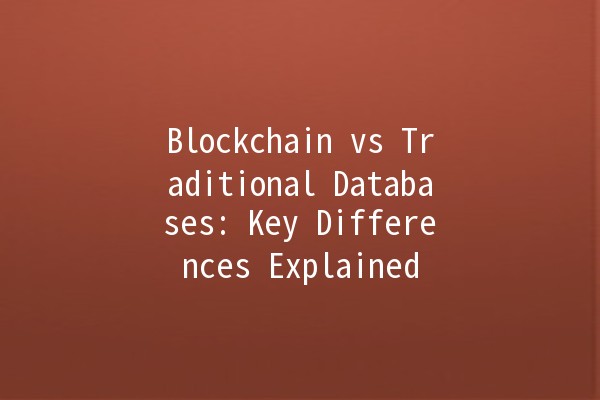




Blockchain technology has emerged as a revolutionary method for storing data. Unlike traditional databases, it offers a decentralized system constructed to ensure transparency, security, and immutability of the information stored. To provide a clear understanding of how blockchain differs from conventional databases, we will explore core attributes and functionalities, including various methods of data storage, access rights, and the technology's implications across sectors.

Traditional databases are often centralized, which means they rely on a single point of authority or server for data management. In contrast, blockchain operates on a decentralized network where each participant (node) has access to the full database, ensuring that no single entity has control over all the data.
Example: In the banking sector, a traditional database would store customer records in one centralized system. If that system goes offline, access is lost. Conversely, with blockchain, every bank node maintains copies of records, making availability constantly robust.
Once data is added to a blockchain, it cannot be altered or deleted. This is achieved through cryptographic hashing. Traditional databases can allow modification or deletion of entries, which can lead to inconsistency and data tampering.
Example: In supply chain management, if a product's journey from manufacturer to retailer is stored on a blockchain, every transaction remains part of an unchangeable record, promoting trust among users. Traditional databases, however, face the risk of records being overwritten or altered.
Transactions on a blockchain are visible to all nodes within the network, allowing for greater accountability. Traditional databases offer limited transparency as access is often restricted to specific users.
Example: In a voting system implemented on a blockchain, every vote can be traced back publicly, ensuring fair play. In contrast, votes stored in traditional databases can sometimes be manipulated or hidden.
Blockchain utilizes consensus mechanisms (like Proof of Work or Proof of Stake) to validate transactions before they are added to the chain. Traditional databases depend heavily on trusted third parties to authorize data changes.
Example: In cryptocurrency transfers, a majority must verify transactions before completion, preventing fraud. In traditional systems, a bank must authorize each transaction, presenting a dependence on the institution's integrity.
Blockchain enhances security through its structure. Data is encrypted, and an attacker would need to compromise a majority of the nodes to alter the records. Traditional databases are more vulnerable to data breaches and hacking due to their centralized nature.
Example: A bank database breach can lead to widespread theft of customer data. A blockchain system, however, risks far fewer breaches due to its decentralized, cryptographically secure architecture.
Transitioning to blockchain technology not only leverages these unique advantages but also provides organizations substantial productivity boosts. Here are five practical productivity enhancement tips using blockchain technology, along with examples of their application:
Explanation: By utilizing blockchain in supply chains, organizations can track products throughout their lifecycle—from creation to sale.
Application Example: Companies like Walmart employ blockchain to trace the origin of food products. This transparency allows for faster recalls in case of contamination, significantly reducing the time and cost involved.
Explanation: Smart contracts automatically execute agreements when predetermined conditions are met, minimizing human error and potential fraud.
Application Example: In real estate, smart contracts can facilitate the sale process, releasing funds to sellers only once all conditions of the sale are fulfilled, thus ensuring transparency and security.
Explanation: Blockchain can enhance identity management systems, enabling secure and fast verification processes.
Application Example: Companies like Civic use blockchain to verify identities securely without the need for sensitive personal data, reducing the overhead associated with traditional identity checks.
Explanation: By decentralizing data storage, blockchain technology increases security, as data isn't stored in a single location that could be hacked.
Application Example: Health organizations storing patient records on a blockchain can provide patients with secure access while keeping their sensitive data encrypted from unauthorized access.
Explanation: Blockchain allows for direct peertopeer transactions, removing the need for intermediaries.
Application Example: Platforms like Ethereum enable users to conduct transactions without banks, effectively reducing costs associated with processing fees and delays.
Blockchain technology is primarily used in cryptocurrencies, supply chain management, and identity verification. Industries are exploring further applications such as voting systems, healthcare data management, and property registration, leveraging blockchain to enhance transparency, efficiency, and security.
Blockchain employs hashing, a secure method that transforms information into a unique string of characters. Once recorded, this data is fixed into the block and linked to the previous block. This chain structure makes it nearly impossible to alter historical data without detection, maintaining the integrity of all stored information.
Despite its advantages, blockchain technology faces challenges such as scalability, energy consumption associated with consensus mechanisms, and regulatory concerns across different jurisdictions. Addressing these issues is crucial for wider adoption and implementation of blockchain solutions.
Yes, organizations can integrate blockchain with traditional databases to enhance security and efficiency while maintaining continuity in existing systems. Hybrid models can optimize data management while leveraging the unique benefits blockchain offers.
The initial costs of implementing blockchain technology can be high due to system integration and development. However, the longterm savings and efficiencies gained can outweigh these upfront costs, particularly in sectors like finance and supply chain where transaction overhead is significant.
Professionals in the blockchain field typically require skills in programming languages (such as Solidity for Ethereum), an understanding of cryptographic principles, data structures, and problemsolving capabilities. Staying updated with the latest trends and legislation surrounding blockchain is also essential.
Blockchain is a transformative technology promising to reshape industries by enhancing security, efficiency, and transparency. As organizations increasingly recognize its value, understanding the differences between blockchain and traditional databases becomes vital for strategic decisionmaking and innovation.
Transitioning effectively to blockchain can pave the way for a more productive, secure, and reliable future in data management. By leveraging its unique features, organizations can not only improve their internal operations but also provide better services to their customers, ensuring longterm success in a rapidly evolving digital landscape.